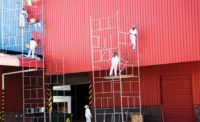2020 Top Standards: OSHA most frequently violated standards
Scaffolding (1926.451)

Scaffolding was the third most-frequently cited agency standard in FY 2019.
Enforcement citations FY 2019: 3,018
Number of inspections: 1,503
Proposed penalties: $9,542,890
Most frequently cited industries:
- Construction
- Manufacturing
- Wholesale Trade
- Administrative and Support and Waste Management and Remediation Services
Common hazards
- Falls from elevation, due to lack of fall protection.
- Collapse of the scaffold, caused by instability or overloading.
- Being struck by falling tools, work materials, or debris.
- Electrocution, due to the proximity of the scaffold to overhead power lines.
Key provisions
Fall protection or fall arrest systems: Each employee more than 10 feet above a lower level shall be protected from falls by guardrails or a fall arrest system, except those on single-point and two-point adjustable suspension scaffolds. Each employee on a single-point and two-point adjustable suspended scaffold shall be protected by both a personal fall arrest system and a guardrail. 1926.451(g)(1)
Guardrail height: The height of the toprail for scaffolds manufactured and placed in service after January 1, 2000 must be between 38 inches (0.9 meters) and 45 inches (1.2 meters). The height of the toprail for scaffolds manufactured and placed in service before January 1, 2000 can be between 36 inches (0.9 meters) and 45 inches (1.2 meters). 1926.451(g)(4)(ii)
Crossbracing: When the crosspoint of crossbracing is used as a toprail, it must be between 38 inches (0.97 m) and 48 inches (1.3 meters) above the work platform. 1926.451(g)(4)(xv)
Midrails: Midrails must be installed approximately halfway between the toprail and the platform surface. When a crosspoint of crossbracing is used as a midrail, it must be between 20 inches (0.5 meters) and 30 inches (0.8 m) above the work platform. 1926.451(g)(4)
Footings: Support scaffold footings shall be level and capable of supporting the loaded scaffold. The legs, poles, frames, and uprights shall bear on base plates and mud sills. 1926.451(c)(2)
Platforms: Supported scaffold platforms shall be fully planked or decked. 1926.451(b)
Guying ties, and braces: Supported scaffolds with a height-to-base of more than 4:1 shall be restained from tipping by guying, tying, bracing, or the equivalent. 1926.451(c)(1)
Capacity: Scaffolds and scaffold compponents must support at least 4 times the maximum intended load. Suspension scaffold rigging must at least 6 times the intended load. 1926.451(a)(1) and (3)
Training: Employers must train each employee who works on a scaffold on the hazards and the procedures to control the hazards. 1926.454
Inspections: Before each work shift and after any occurrence that could affect the structural integrity, a competent person must inspect the scaffold and scaffold components for visible defects. 1926.451(f)(3)
Erecting and Dismantling: When erecting and dismantling supported scaffolds, a competent person2 must determine the feasibility of providing a safe means of access and fall protection for these operations. 1926.451(e)(9) & (g)(2)
What is a scaffold?
A scaffold is an elevated, temporary work platform. There are two basic types of scaffolds:
- Supported scaffolds, which consist of one or more platforms supported by rigid, load- bearing members, such as poles, legs, frames, outriggers, etc.
- Suspended scaffolds, which are one or more platforms suspended by ropes or other non-rigid, overhead support.
- Other types of equipment, principally scissor lifts and aerial lifts, can be regarded as other types of supported scaffolds.
Who works with scaffolds?
1. Erectors/dismantlers
Erectors and dismantlers are workers whose principal activity involves assembling and disassembling scaffolding before other work can begin, and after that work, or a portion of it, has been completed.
OSHA requires employers to provide training by a competent person to each employee who is involved in erecting and/or disassembling a scaffold. A competent person is defined as one who:
- Is capable of identifying existing and predictable hazards.
- Has authorization to take prompt corrective measures to eliminate such hazards.
Scaffolds must be designed by a qualified person and be constructed and loaded in accordance with that design. OSHA defines a qualified person as one who:
- Possesses a recognized degree, certificate, or professional standing, or
- By extensive knowledge, training, and experience has successfully demonstrated the ability to solve or resolve problems relating to the subject matter, the work, or the project.
A qualified person must do adequate preplanning to assure the safe erection and use of the scaffold. Preplanning includes:
- Determining the type of scaffold necessary for the job.
- Determining the maximum load for the scaffold.
- Assuring a good foundation.
- Avoiding electrical hazards.
2. Users
Scaffold users are workers whose work requires them to be supported by scaffolding to access the area of a structure where that work is performed.
Employers are required by OSHA standards to have a qualified person provide training to each employee who performs work while on a scaffold. The training must enable employees to recognize the hazards associated with the type of scaffold being used and to understand the procedures to control or minimize those hazards.
3. Designers
Scaffold designers are workers who are qualified to design scaffolds. Designers for certain scaffolds also must be registered professional engineers. Non-mobile scaffolds must not be moved horizontally with workers on them, unless a registered professional engineer designed the scaffold specifically for the move. [29 CFR 1926.451(f)(5)]. Note: To move mobile scaffolds, see 29 CFR 1926.452(w).
Pole scaffolds over 60 feet in height must be designed by a registered professional engineer, and shall constructed and loaded according to that design. [29 CFR 1926.452(a)(10)].
Tube and Coupler scaffolds over 125 feet in height must be designed by a registered professional engineer, and must be constructed and loaded according to that design. [29 CFR 1926.452(b)(10)].
Fabricated frame scaffolds (tubular welded frame scaffolds, welded end frame scaffolds, walk through frame scaffolds) over 125 feet in height must be designed by a registered professional engineer, and constructed and loaded according to that design. [29 CFR 1926.452(c)(6)].
Outrigger scaffolds: Scaffolds and scaffold components must be designed by a registered professional engineer, and constructed and loaded per that design. [29 CFR 1926.452(i)(8)].
|
2020 Top Standards Article Index ANSI/ISEA 121- Dropped object prevention solutions NFPA 652 standard on fundamentals of combustible dust OSHA most frequently violated standardsFall protection- General Requirements (1926.501) Hazard Communication (1910.1200) The Control of Hazardous Energy (Lockout/Tagout) 1910.147 Respiratory Protection (1910.134) Powered Industrial Trucks (1910.178) |
Looking for a reprint of this article?
From high-res PDFs to custom plaques, order your copy today!





